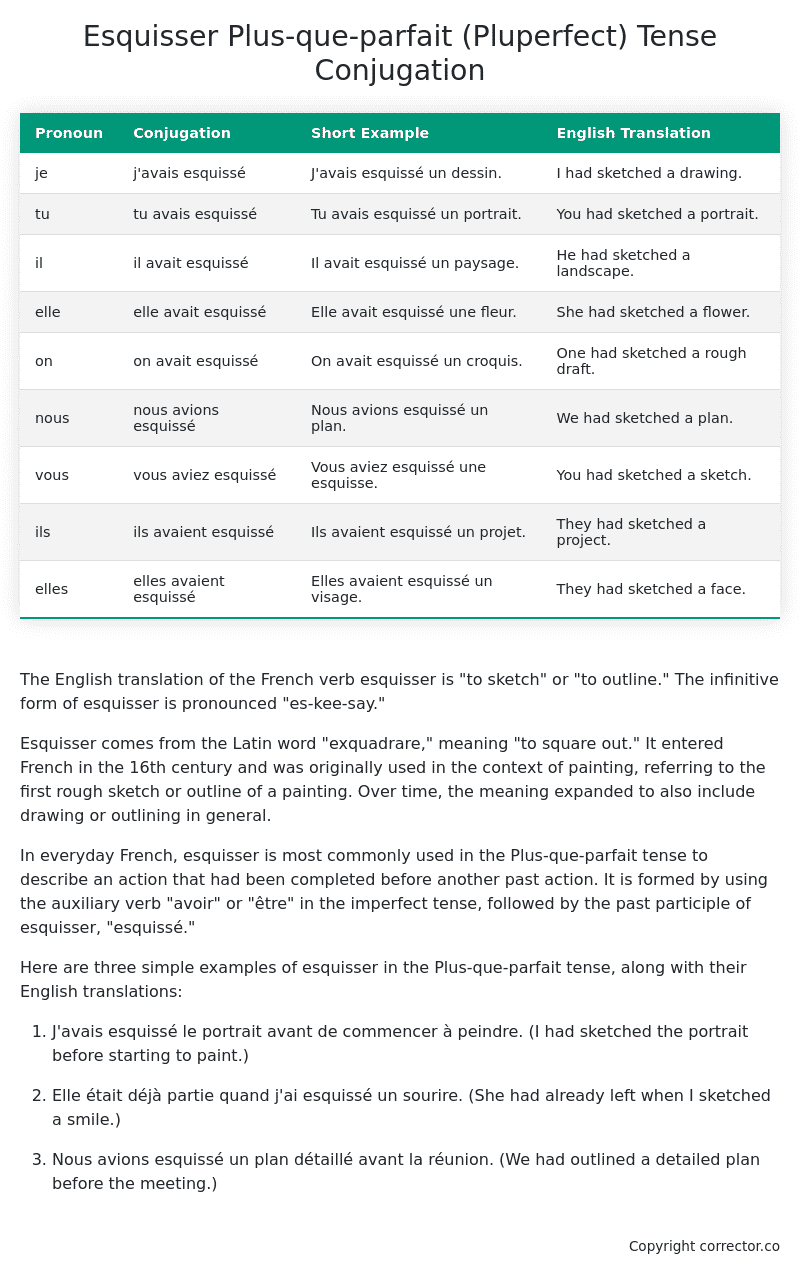Plus-que-parfait (Pluperfect) Tense Conjugation of the French Verb esquisser
Introduction to the verb esquisser
The English translation of the French verb esquisser is “to sketch” or “to outline.” The infinitive form of esquisser is pronounced “es-kee-say.”
Esquisser comes from the Latin word “exquadrare,” meaning “to square out.” It entered French in the 16th century and was originally used in the context of painting, referring to the first rough sketch or outline of a painting. Over time, the meaning expanded to also include drawing or outlining in general.
In everyday French, esquisser is most commonly used in the Plus-que-parfait tense to describe an action that had been completed before another past action. It is formed by using the auxiliary verb “avoir” or “être” in the imperfect tense, followed by the past participle of esquisser, “esquissé.”
Here are three simple examples of esquisser in the Plus-que-parfait tense, along with their English translations:
-
J’avais esquissé le portrait avant de commencer à peindre. (I had sketched the portrait before starting to paint.)
-
Elle était déjà partie quand j’ai esquissé un sourire. (She had already left when I sketched a smile.)
-
Nous avions esquissé un plan détaillé avant la réunion. (We had outlined a detailed plan before the meeting.)
Table of the Plus-que-parfait (Pluperfect) Tense Conjugation of esquisser
| Pronoun | Conjugation | Short Example | English Translation |
|---|---|---|---|
| je | j’avais esquissé | J’avais esquissé un dessin. | I had sketched a drawing. |
| tu | tu avais esquissé | Tu avais esquissé un portrait. | You had sketched a portrait. |
| il | il avait esquissé | Il avait esquissé un paysage. | He had sketched a landscape. |
| elle | elle avait esquissé | Elle avait esquissé une fleur. | She had sketched a flower. |
| on | on avait esquissé | On avait esquissé un croquis. | One had sketched a rough draft. |
| nous | nous avions esquissé | Nous avions esquissé un plan. | We had sketched a plan. |
| vous | vous aviez esquissé | Vous aviez esquissé une esquisse. | You had sketched a sketch. |
| ils | ils avaient esquissé | Ils avaient esquissé un projet. | They had sketched a project. |
| elles | elles avaient esquissé | Elles avaient esquissé un visage. | They had sketched a face. |
Other Conjugations for Esquisser.
Le Present (Present Tense) Conjugation of the French Verb esquisser
Imparfait (Imperfect) Tense Conjugation of the French Verb esquisser
Passé Simple (Simple Past) Tense Conjugation of the French Verb esquisser
Passé Composé (Present Perfect) Tense Conjugation of the French Verb esquisser
Futur Simple (Simple Future) Tense Conjugation of the French Verb esquisser
Futur Proche (Near Future) Tense Conjugation of the French Verb esquisser
Plus-que-parfait (Pluperfect) Tense Conjugation of the French Verb esquisser (this article)
Passé Antérieur (Past Anterior) Tense Conjugation of the French Verb esquisser
Futur Antérieur (Future Anterior) Tense Conjugation of the French Verb esquisser
Subjonctif Présent (Subjunctive Present) Tense Conjugation of the French Verb esquisser
Subjonctif Passé (Subjunctive Past) Tense Conjugation of the French Verb esquisser
Subjonctif Imparfait (Subjunctive Imperfect) Tense Conjugation of the French Verb esquisser
Subjonctif Plus-que-parfait (Subjunctive Pluperfect) Tense Conjugation of the French Verb esquisser
Conditionnel Présent (Conditional Present) Tense Conjugation of the French Verb esquisser
Conditionnel Passé (Conditional Past) Tense Conjugation of the French Verb esquisser
L’impératif Présent (Imperative Present) Tense Conjugation of the French Verb esquisser
L’infinitif Présent (Infinitive Present) Tense Conjugation of the French Verb esquisser
Struggling with French verbs or the language in general? Why not use our free French Grammar Checker – no registration required!
Get a FREE Download Study Sheet of this Conjugation 🔥
Simply right click the image below, click “save image” and get your free reference for the esquisser Plus-que-parfait tense conjugation!

Esquisser – About the French Plus-que-parfait (Pluperfect) Tense
Tense Formation
Common everyday usage patterns
Sequencing of past events
Background information
Hypothetical or reported speech
Interactions with other tenses
Summary
I hope you enjoyed this article on the verb esquisser. Still in a learning mood? Check out another TOTALLY random French verb conjugation!


